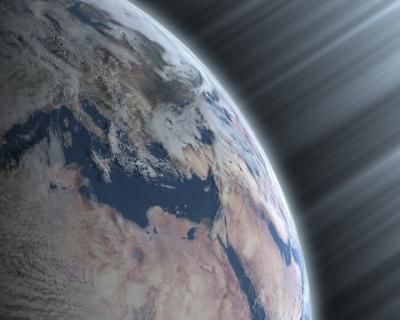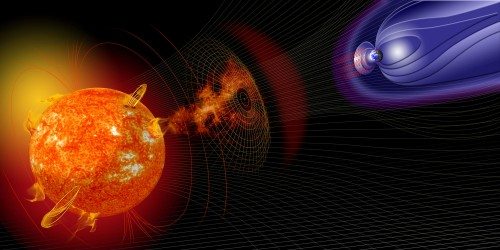Cosmic rays were discovered unexpectedly in 1912. It is now known that most cosmic rays are atomic nuclei. Most are hydrogen nuclei, some are helium nuclei, and the rest heavier elements. In 1995, Henrik Svensmark discovered a startling connection between the cosmic ray flux from space and cloud cover. He found that when the sun is more active–more sunspots, a stronger magnetic field, larger auroras, stronger solar winds, etc.–fewer cosmic rays strike the earth and cloud cover is reduced, resulting in warmer temperatures. Svensmark offers a complete chain of events that explains the variations in global temperature that have puzzled climatologists for so many years, and that has now led to an explanation for the recent global warming episode that ended approximately 17 years ago.
Changes in solar activity change the flow of small, charged, highly energetic particles (known as cosmic rays) that travel through the atmosphere toward Earth. These particles in turn create more ions (charged atoms or molecules) from air molecules in the atmosphere, and it has been suggested that these ions might modify cloud formation, causing large changes in weather and temperatures below.
An experiment at CERN, Europe’s high-energy physics laboratory near Geneva, Switzerland, confirmed this theory of cloud formation and cosmic rays. For a century, scientists have known that charged particles from space constantly bombard Earth. Known as cosmic rays, the particles are mostly protons blasted out of supernovae. As the protons crash through the planet’s atmosphere, they can ionize volatile compounds, causing them to condense into airborne droplets, or aerosols. Clouds then build up around the droplets.

A paper published in Environmental Research Letters in 2014 corroborates the Svensmark cosmic ray theory of climate, whereby tiny 0.1% changes in solar activity are amplified via the effect on cosmic rays and cloud formation, which in turn may control global temperatures. The authors find cosmic ray variations due to changes over solar cycles may have as much as 10 times larger effect than previous studies have estimated. The paper also finds that a tiny 0.2C temperature increase increases the cosmic ray induced cloud condensation nuclei by around 50%, thus acting as a natural homeostatic mechanism.
The sun, normally puts out a higher velocity of solar wind that protects the earth from cosmic rays. During periods of low solar activity, which we are now experiencing, the solar winds decrease allowing more cosmic rays to penetrate, which increases cloud formation, which would be the main cooling mechanism from diminished solar activity. Whatever theories are presented we have history to tell us that we have had mini ice ages at times when the sun has shown diminished sun spot activity.
Tiny changes in the earth’s cloud cover could account for variations in temperature of several degrees, most climatologists believe, so this could explain what we are seeing with intensifying rainfall. The amount of ultra fine condensation nuclei (UFCN) material depends on the quantity of the background drizzle of cosmic rays. Normally this quantity varies depending on the strength of the sun’s magnetic field and the strength of the Earth’s magnetic field. But lately there seems to be an unexplained increase in cosmic rays and this is troubling scientists.
Tiny changes in the earth’s cloud cover could account for variations in temperature of several degrees, most climatologists believe, so this could explain what we are seeing with intensifying cooling. The amount of ultra-fine condensation nuclei (UFCN) material depends on the quantity of the background drizzle of cosmic rays. Normally this quantity varies depending on the strength of the sun’s magnetic field and the strength of the Earth’s magnetic field. But lately there seems to be an unexplained increase in cosmic rays and this is troubling scientists.
“The effect of solar cycle perturbation on cloud condensation nuclei based on present study is generally higher than those reported in several previous studies, up to around one order of magnitude 10 times…Our global simulations indicate that a decrease in ionization rate associated with galactic cosmic ray flux change from solar minimum to solar maximum reduces annual mean nucleation rates, number concentration of cloud condensation nuclei larger than 10 nm… by 6.8%, 1.36%…respectively. The inclusion of 0.2 °C temperature increase enhances the CCN cloud condensation nuclei solar cycle signals by around 50%.”

The world’s most sophisticated particle study laboratory – CERN in Geneva – announced that more cosmic rays do indeed create more clouds in earth’s atmosphere. Henrik Svensmark of the Danish Space Research Institute cloud chamber experiment showed natural cosmic rays quickly created vast numbers of tiny “cloud seeds.” Since clouds often cover 30% of the earth’s surface, a moderate change in cloud cover clearly could explain the warming/cooling cycle. Svensmark noted the gigantic “solar wind” that expands when the sun is active – and thus blocks many of the cosmic rays that would otherwise hit the earth’s atmosphere. When the sun weakens, the solar wind shrinks. Recently, the U.S. Solar Observatory reported a very long period of “quiet sun” and predicted 30 years of cooling.
Interesting recently at the South Pole increased levels of cosmic rays have been detected crashing into the Earth and they appear to be coming from a particular location rather than being distributed uniformly across the sky. Scientists know of no source close enough to produce this pattern. “We don’t know where they are coming from,” says Stefan Westerhoff of the University of Wisconsin-Madison. It’s a mystery because the hotspots must be produced within about 0.03 light years of Earth. Further out, galactic magnetic fields should deflect the particles so much that the hotspots would be smeared out across the sky. But no such sources are known to exist.

Back in 1996 Danish physicists suggested that cosmic rays, energetic particles from space, are important in the formation of clouds. Since then, experiments in Copenhagen and elsewhere have demonstrated that cosmic rays actually help small clusters of molecules to form. By firing a particle beam into a cloud chamber, physicists in Denmark and the UK have shown how cosmic rays could stimulate the formation of water droplets in the Earth’s atmosphere. The researchers say this is the best experimental evidence yet that the Sun influences the climate by altering the intensity of the cosmic-ray flux reaching the Earth’s surface.
Most of us are not physicists so we do not pay attention to the subtle world of energies that surround us. It is not only the sun that is weakening demonstrating few and sometimes no sunspot activity. Earth’s magnetic field is also weakening “setting into motion a chain of events which causes destabilizing of Earth’s fluids – mostly of magma and also oceans and ice. These natural cyclical events cause the shifting of weather patterns, climate, elevated earth changing events such as earthquakes, volcanoes, tornadoes, hurricanes etc.”
Upon reaching the lower atmosphere where more sulphur dioxide, water vapor, and ozone is present, the cosmic rays ionize the air, releasing electrons that aid in the formation of more cloud condensation nuclei and form more dense clouds. This increase in low-cloud amount reflects more solar energy to space, cooling the planet. The increasingly intense rain and snow storms can, in all likelihood, be attributed to the decreasing solar winds and increasing cosmic rays that are penetrating the earth.

“The sun is a variable star, which emits both electromagnetic radiation and energetic particles known as the solar wind – these are released as a plasma carrying a fingerprint of the solar magnetic field throughout inter-planetary space. Effects from the solar wind are felt at distances well beyond Neptune, possibly up to 200 AU from the sun, in a region of space known as the Heliosphere (figure 1). The flux of the inter-planetary magnetic field (IMF) at 1AU is 5nT. Variability in solar activity affects both the radiative output of the sun and the strength of the IMF carried by the solar wind. The IMF shields the heliosphere from galactic cosmic radiation which, consists of energetic particles, mainly protons that are accelerated through stellar processes in our galaxy. Thus, solar variability modulates both the flux of incoming galactic cosmic radiation (GCR) and the amount of solar radiation received by the planets. Historical evidence over the past 1000 years indicates that changes in climate have occurred in accord with variability in cosmic ray intensities”

